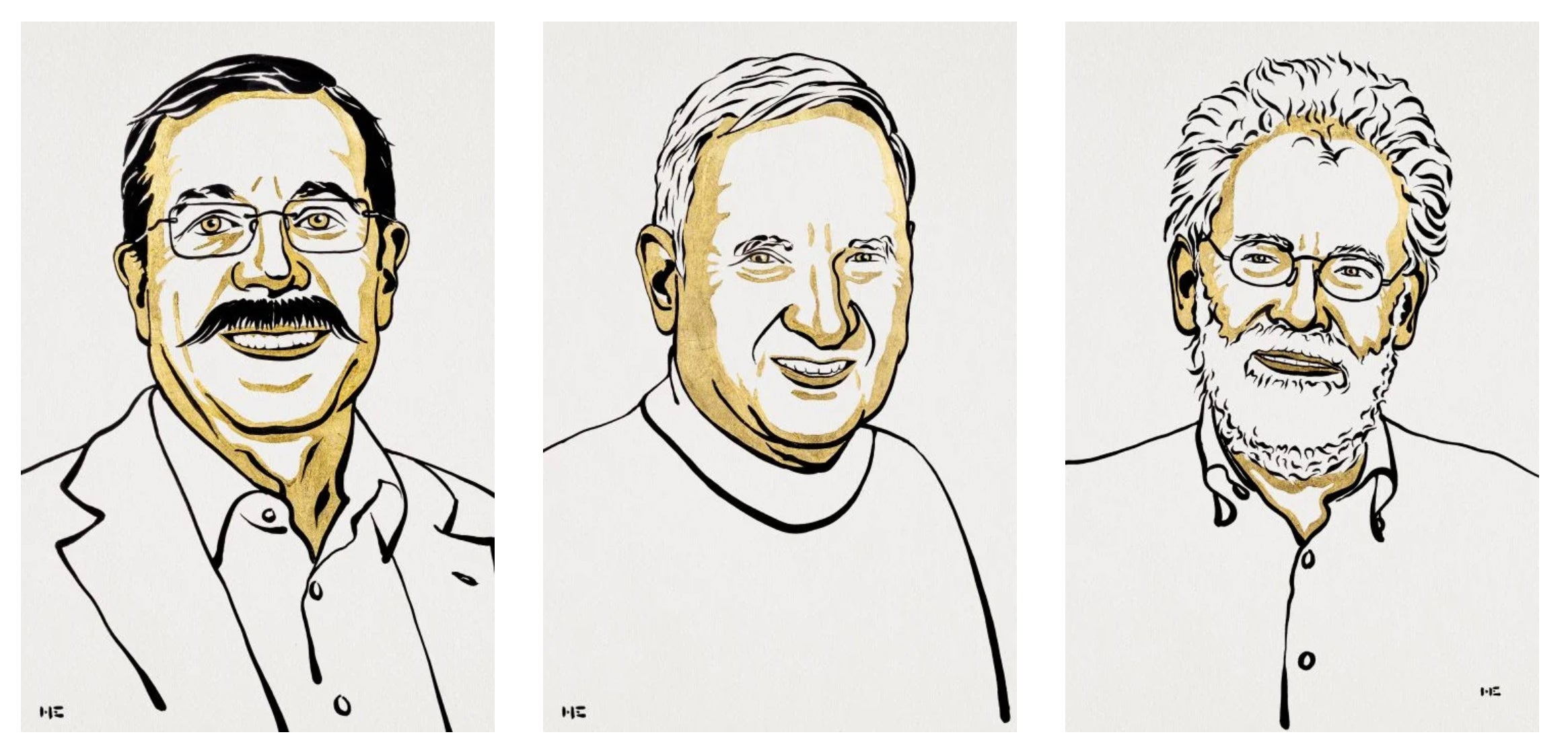This year’s Nobel Prize in Physics was awarded in equal parts to Alain Aspect of the University of Paris-Saclay, John F. Clauser of J. F. Clauser & Associates, and Anton Zeilinger of the University of Vienna, for their pathfinding work in quantum mechanics and quantum information science.
Working independently, each of the three researchers forged new experiments demonstrating and investigating quantum entanglement, the curious phenomenon in which two or more particles exist in a so-called entangled state. In this bizarre situation, an action taken on one of the particles can instantaneously ripple through the entire entangled assemblage, predicting the other particles’ behavior, even if they are far apart. If an observer determines the state of one such particle, its entangled counterparts will instantly reflect that state—whether they are in the same room as the observer or in a galaxy on the opposite side of the universe. Although this phenomenon has become an essential aspect of modern quantum technologies, it is so counterintuitive and seemingly impossible that Albert Einstein once famously derided it as “spooky action at a distance.”
The scientists’ work has collectively addressed core enigmas that were deeply investigated in the 1960s by Northern Irish physicist John Stewart Bell, who sought to understand what entanglement’s “spookiness” implies about the fundamental nature of reality. Could it be, as Einstein believed, that all objects—whether planets or particles—possess fundamental properties that can be discerned through precise observation? If so, quantum weirdness would only be an illusion arising from the failure of quantum mechanics to account for as-yet-undiscovered “hidden variables” inherent to the particles that populate the subatomic world. By preordaining the states of widely separated entangled particles before those particles were measured, hidden variables would neatly explain how they managed to reflect each other’s state without information traveling between them faster than the speed of light—a profound violation of one of the most fundamental tenets of physics. Einstein’s idea flew in the face of an alternative preferred by Niels Bohr, Erwin Schrödinger and other physicists, who rejected the notion of such hidden variables. Reality, they said, is inherently fuzzy, and particles only gain certain specific characteristics upon being measured.
Expanding on a concept proposed some three decades prior by Einstein and his physicist colleagues Boris Podolsky and Nathan Rosen, in 1964 Bell showed that if hidden variables existed, their presence could be experimentally inferred through careful measurements of multiple pairs of entangled particles. When, for instance, such particles’ spins are measured along a varying directional axis (that is, not only “up” or “down” but also various states in between), certain correlations between the collective paired spins should be much stronger if they are dictated purely by quantum mechanics and correspondingly weaker if they are influenced by hidden variables. Performing this experiment could thus confirm that reality, at its heart, is purely quantum mechanical or instead reveal the presence of deeper, more fundamental layers of physical complexity. Such “Bell tests,” however, contain multiple potential loopholes that could confound their results. And across decades, legions of researchers have ardently worked to close them.
In 1969 Clauser was the first to conceive a practical Bell test, which involved measuring quantum entanglement by determining the polarization of entangled photon pairs launched in opposite directions. He then performed the experiment in 1972 alongside the late Stuart Freedman, who was then a graduate student, confirming that the photons acted in concert despite their physical separation. Clauser’s work indicated that hidden variables could not explain entanglement’s effects, suggesting that quantum theory remained intact as an essentially complete description of reality.
But the loopholes remained. And about 10 years later, after refining Clauser’s experiment, Aspect and his collaborators closed one of them by developing a way to switch the directions of entangled photon pairs in billionths of a second—after the photons had left their source but before they arrived at a detector. This ensured that the measurement settings that existed when the photons were emitted could not affect the ultimate result, greatly reinforcing the notion that hidden variables do not exist. Whatever fundamentally occurs during the measurement of entangled particles (still a topic of intense debate among scientists), Aspect’s work showed it does so within the confines of existing quantum theory. The last major loophole for Bell tests was closed in 2015 through the work of four different research groups.
Zeilinger and his group greatly expanded the use and study of entangled quantum states. In 1997, they were one of two research groups (the other led by Italian physicist Francesco De Martini) to independently demonstrate a phenomenon called quantum teleportation, which uses entanglement to allow quantum states to be moved from one particle to another across arbitrary distances. Zeilinger’s group went on to achieve several more “firsts” in quantum information science. Today, quantum teleportation has become central for nascent efforts to build a globe-spanning “quantum Internet.” And Zeilinger collaborated on work that successfully used the technique to create China’s Micius spacecraft, the first quantum communications satellite.

During the prize’s announcement, Eva Olsson, a member of the Nobel Committee for Physics, said Aspect’s, Clauser’s and Zeilinger’s work has “opened doors to another world, and it has also shaken the very foundations of how we interpret measurements.”
Collectively, the trio’s research has contributed greatly to quantum information science, the scientific field underpinning the ongoing race to develop practical devices and techniques that leverage quantum principles to achieve breakthroughs in computing, communications and cryptography.
“The work of Aspect, Clauser and Zeilinger provides the practical theoretical method and conclusive experimental measurements that underline the distinction between the quantum and classical worlds, showing that quantum objects can be related through entanglement in a way that is not possible with classical objects,” says Andrew Cleland, a quantum physicist at the University of Chicago. “Their work forms the fundamental basis for quantum computation and quantum communication.”
John Preskill, a leading quantum information scientist at the California Institute of Technology, notes that many mature technologies are already “quantum” in some sense: lasers, magnetic resonance imaging machines and multibillion-transistor computer chips all rely on quantum mechanics unfolding on subatomic scales. “But those technologies,” he says, “have only scratched the surface of how quantum theory has modified our view of what’s possible in the universe.”
And, Preskill adds, “the burgeoning investments in quantum technologies now occurring all over the world are building on scientific foundations which flow from the pioneering work of Bell, Clauser, Aspect and Zeilinger.”
In a press conference shortly after the announcement, Zeilinger expressed shock at being awarded the prize and acknowledged the influence of his academic adviser Helmut Rauch, as well as the “more than 100 young people who worked with me over the years and made this all possible.” Despite the myriad emerging applications for quantum entanglement, Zeilinger said that what most inspires him remains the mystery it still poses about the nature of reality. “Some of the fundamental questions—the very question ‘What does this really mean?’—in a basic way, are still unanswered in my eyes,” he said. “And that is an avenue for new research.”







